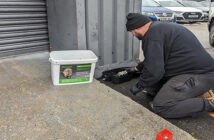Make no mistake, the future for second-generation anticoagulant rodenticides (SGARs) is far from secure and all users need to engage in the stewardship process. This was the key message to come out of the Pest Control News (PCN) Workshop held during PestTech 2013.
The PCN Workshop traditionally takes a controversial topic and 2013 was no exception.
Dr Alan Buckle, chairman of CRRU, provided a whistle stop tour of how we have got to the point where a stewardship programme has to be developed to ensure the continued availability of these essential; pest management tools. Then, Alan, along with a panel consisting of BPCA chief executive Simon Forrester, NPTA chairman Iain Turner and Dave Oldbury representing the CIEH National Pest Advisory Panel (NPAP) chaired by Killgerm managing director Rupert Broome, fielded questions from the audience.
To be honest the reasons why a stewardship programme must be developed are now really only of academic interest.It no longer matters whether we agree with the conclusions that rodenticides are Persistent Bioaccummulative & Toxic (PBTs), Carcinogenic Mutagenic and Reprotoxic (CMR) and/or cause significant secondary poisoning amongst UK wildlife, especially in birds of prey.
| The fact is that the European Parliament, the European Commission, the UK Government and the HSE have asked for stewardship and if the industry doesn’t knuckle down and produce a workable system then they will impose their own restrictions.
The good news is that provided stewardship is introduced, the HSE has more or less said it will be happy to approve all second generation anticoagulants for use ”in and around” buildings and at a distance as far away from the buildings that is judged necessary to gain control of a rodent infestation. Stewardship will apply to all rodenticide usage sectors – gamekeeping, agriculture, amateur and professional pest control. |
|
|
|
This is a massive change in the regulatory position in the UK and implementing stewardship will require an equally massive effort across the usage sectors to develop and implement good stewardship. CRRU is acting as the coordinator but, for each usage sector, a group has been formed to work out the detail of the stewardship required and to drive forward implementation. Meetings have already been held and more are scheduled with stewardship likely to arrive early in 2014. After some discussion about the problems of amateur use the audience was reminded that all sectors must pull together and that it is our job as professional pest managers to sort out our own sector. One topic which continues to cause considerable confusion is permanent perimeter baiting. It is unfortunate that the 35-day advice now coming in on labels has been shortened to the 35 day rule as it is not a rule it is advice. If after 35 days of baiting a rodent problem has not been controlled then it is essential to re-assess the situation. If you can justify continued baiting then you can continue but, since control should normally be achievable within 35-days, you do need some good reasons to justify the continued use of toxic baits. Speaking from the floor, Roland Higgins from the European Confederation of Pest Control Associations (CEPA) summed up the situation well and received a round of applause for his comments: “I ask you to support this stewardship initiative. Looking at the bigger picture we are not just under scrutiny, we are under attack. This is a textbook example of what to do, cooperate and self-regulate to avoid the imposition of outside restrictions. And, because the British Civil Service is very influential in the Environment Directorate in Brussels, what happens in the UK is also likely to happen in the rest of Europe.” To conclude, we must not kid ourselves, if we don’t get our act together, there will be severe restrictions placed on the use of SGARs or we might even loose them altogether.environments. Read more about why stewardship is necessary, and what the HSE requires in the stewardship programme. |
||

 The PCN Workshop panel, left to right: NPTA”s Iain Turner,
The PCN Workshop panel, left to right: NPTA”s Iain Turner, 
